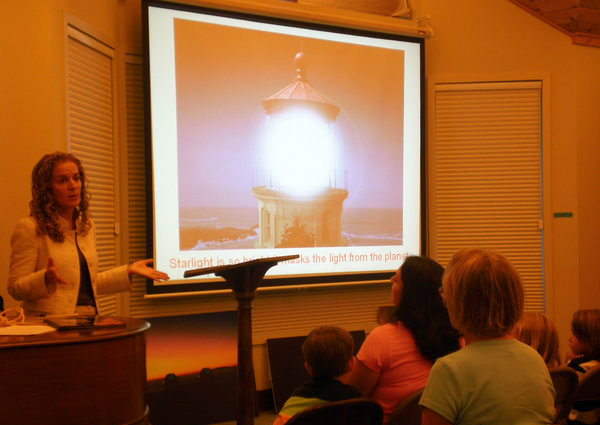
The temperature is far below zero. In order to breathe, oxygen has to be inhaled from a tank. The night is pitch black, the darkness broken only by the stars.
Vicky Wittenstein is here to do research for her new book on planet hunting, but she’s not in outer space, no matter how closely the setting might resemble it. She is, in fact, 14,000 feet above sea level on the top of a dormant volcano in Hawaii, shadowing astronomer Geoff Marcy in the W.M. Keck Observatory as he practices the techniques that he pioneered to search for planets orbiting stars beyond our solar system.
“I always knew that being an astronomer was exciting,” Ms. Wittenstein said in a recent interview, “but I never knew how much of an adventure it was, how rugged. Research science puts people in the mind set of white coats and sterile laboratories but, really, they are pioneers in a very literal sense.”
It is this sense of adventure that Ms. Wittenstein hopes to convey to young readers in “Planet Hunter: Geoff Marcy and the Search for Other Earths,” which she spoke about at the Quogue Library one weekend earlier this summer.
Mr. Marcy, a professor at the University of California at Berkeley and the primary subject of Ms. Wittenstein’s book, developed a method called Doppler spectroscopy, often referred to as the “wobble method,” to detect planets in distant space that are masked by the bright light of the star that they orbit.
Doppler spectroscopy utilizes the gravitational force that pulls planets and stars toward one another, and registers when a star deviates, or “wobbles,” from its usual position toward an orbiting planet that may be too small or too dim for telescopes to pick up.
Using this technique, Mr. Marcy has found or helped to find nearly half of the 400-plus known planets that lie outside Earth’s solar system, and he and his team are going to keep finding more.
“There are going to be so many wonderful opportunities for our kids in the upcoming decades, with all the new discoveries that are happening now,” Ms. Wittenstein said. “There’s never been a better time for a kid to fall in love with the night sky.”
Ms. Wittenstein is no stranger to romance with the great beyond, and has been passionate about astronomy since her youth, but it was the experience of having her own children that inspired her to write about science in a way that would be accessible for young people.
“I saw there was a dearth in quality non-fiction writing for children, and I wanted to correct that. Everything is sci-fi, aliens and ET sorts of things, but there are so many amazing facts that are even more compelling than the fantasy.”
Indeed, one of Mr. Marcy’s aims is to find planets with similar environments to Earth, planets that offer the possibility of alien life, or an alternative habitat for humans.
Ms. Wittenstein’s writing debut has received rave reviews, and she’s eager to begin research for her next project, although the topic was still up in the air when she was interviewed.
“There are so many fascinating subjects out there,” Ms. Wittenstein said, “and I love learning about anything.”
Still, for now, Ms. Wittenstein is content to enjoy the success of her first book with her family in Brooklyn Heights, and also in Quogue, where she and her husband have been visiting during summers and weekends for the past 23 years.
“It’s wonderful out here,” the author said. “I can see the stars!”